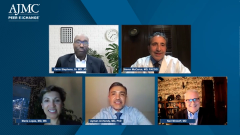
Drivers of Healthcare Utilization in Women’s Health
Kevin Stephens, Sr. MD, JD examines key drivers of healthcare utilization for women of childbearing years.
Episodes in this series

Neil Minkoff, MD: Let me bring Dr Stevens in. Like me and Dr Lopes, you’ve spent a long time as a payer looking at the drivers of health care utilization. These aren’t insignificant drivers. What we were just talking about is the sheer number of patients who end up in the emergency department [ED]. They get imaging and IV opioids and are monitored for a certain amount of time. That has consequences, both medically and societally in terms of what it means to the patient, the cost of care, and so on. What are the things that you think about in your role at UnitedHealth Group in terms of the drivers of health care utilization as we think about women’s health?
Kevin Stephens Sr., MD, JD: That’s a very important question. My whole thing is I like to solve the problem. You can put a Band-Aid on it, but if you don’t fix the problem, you’re going to kick the can down the street. You keep kicking the can. At some point, you have to say, “We need to look at the bigger picture and figure out how we help this patient.” How do we help our client? How do we help get her and her family into a better space and place? Because if not, you just keep kicking, you don’t go anywhere, and you go in circles.
The first thing I look at is what we call disease management, the patient management. We have to look at the age and reproductive concerns, family concerns, and resources allocated, and we have to get her to the right place at the right time with the right person. It was said earlier that many times the patients aren’t seeing the right specialists and aren’t treated. They don’t have an ample trial of medication or medical management, and they may jump straight to surgery. Many times, the surgeons may not be as well trained as some of our panelists are, and they do a TAH [total abdominal hysterectomy]–BSO [bilateral salpingo-oophorectomy]. They just take everything out. For them, that’s the solution. And when someone in reproductive age—
Neil Minkoff, MD: I would posit that a fair number of these people end up in GI [gastrointestinal] before they end up in GYN [gynecology].
Kevin Stephens Sr., MD, JD: That’s absolutely correct. It can be tough surgery too. We’ve all been there and done that, particularly as gynecologists. From the payer perspective, we have to step back and look at the big picture of the patient, look at that their life, and try to help them navigate through this health care delivery system.
Our health care delivery system is tough. You’re right. They go to the emergency department and see an emergency department physician who isn’t a gynecologist but may have been trained a little. Then they go to the PCP [primary care physician], who isn’t a gynecologist. They may even go to a gynecologist who may not be a GYN surgeon capable of doing robotics and some of the more advanced techniques. We’ve tried to work through the patient, figure out what they are, and get them in the right place at the right time with the right person so that the right things can be done.
Neil Minkoff, MD: Let me ask you a follow-up question on that before I broaden the conversation. Is your organization doing any disease management in or around patients who are discharged from the ED with pelvic pain or patients with a diagnosis of fibroids or endometriosis? Are you doing anything to try to steer those patients through the medical system? Or are you depending on the clinicians on the ground who are seeing the patient to do the right work-up and referral?
Kevin Stephens Sr., MD, JD: We’re working on that very issue. We’re trying to make sure in our women’s health that we have wraparound services to address the entire thing and not just 1 component of it. We need to step back a little and look at the big picture. That’s what payers all need to do. We all need to step back because technology has advanced significantly in terms of medical and surgical [options]. GYN is 1 area in which we’ve made tremendous strides medically and surgically. We all have to sit back and look and figure out the best pathway for that patient to get them the outcome, whatever that may be. Some of it may be reproductive. Some of it may be pain-free. Some of it may be lifestyle choices and so forth. We have to work to make that happen for them.
Transcripts edited for clarity.
Newsletter
Stay ahead of policy, cost, and value—subscribe to AJMC for expert insights at the intersection of clinical care and health economics.






























































